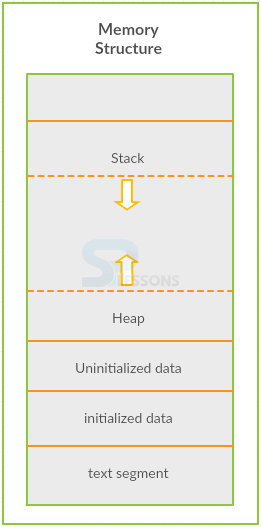 Introduction
Introduction
Every programmer must know how to use the memory efficiently. The programs executed till now used variables such that they are declared during the compile time. Those variable remained constant even at run-time. Here is the tutorial describing the memory allocation at run-time.
The memory in CPU is divided into two main parts. They are :
stack: Stack stores the variables declared in the functions before the run-time.heap: Heap is the free memory provided by the operating system to use during the run-time i.e in dynamic manner.
 Description
Description
Static memory allocation involves allocation of memory to the variables during compile-time. The amount of memory wanted can be known before executing the program. The static memory uses stack memory.
Stack follows FILO (First In Last Out) structure. When a variable is declared, it is pushed into the stack memory. If there is a need of that variable, it is popped out of stack.
 Description
Description
Sometimes, one may not know how much data is entered by the user and how much memory is required by it. This problem occurs mainly during initialization of variables at run-time. To overcome this, heap is requested to allot some memory to the initialized variables. The pointer moves to the heap memory when dynamic memory allocation is implemented.
C++ has special operator called
newto allocate memory dynamically.  Description
Description
Dynamic memory allocation follows two step procedure while allocating memory.
The program creates a pointer of any data type and assigns the keyword "new" to it to request the memory space. If the request is accepted, pointer points to the beginning of assigned heap memory.
The operator applies only to single element. If array of elements are declared, the operator new[] can be used to request a block of memory.
- Pointer declaration.
- Allocation of requested memory.
 Syntax
Syntax
//For single element
new data_type;
//For array of elements
new data_type[array_size];
 Description
Description
The pointer must be declared with a data type. So that memory allots space as per the given data type.
In case of elements, pointer adds the memory to the previous element. It is better to check the pointer location whether the memory is free or not. So, using of NULL to be made as practice in order to find.
double* ptr = NULL; // Initialization of pointer with null
ptr = new double;> // Request memory for ptr
//Arrays declaration
double * ptr = NULL; // Initialization of pointer with null
ptr = new double[20];// Request memory for ptr array
 More Info
More Info
The primary duty of programmer is to check whether the requested memory is provided or not. It can be done in two ways.
[c]int * ptr;
ptr = new (nothrow) int [10];
if(ptr== 0)
{
cout<< " No enough memory" << endl;
}[/c]
- Handling Exceptions : Throwing exceptions is the default method followed by
newoperator. If the requested memory is not granted, exception bad_alloc is occured. - nothrow method: Instead of using exceptions, object called nothrow acts as parameter for new and returns NULL value if memory is not available.
 Description
Description
If the work with requested memory is completed, it has to be given back to the operating system to increase the memory efficiency.
The memory can be freed up by using the operator
delete which is applicable to single elements. If it is applied on arrays, delete removes only the first element in the memory.
Arrays can be removed using the delete[]operator.  Syntax
Syntax
//For single elements
delete variable_name;
//For arrays
delete array_name[array_size];
 Examples
Examples
[c]
#include <iostream>
using namespace std;
int main ()
{
int* ptr = NULL; // Initialization with null
ptr = new int; // Requesting memory
*ptr = 8956; // Storing value at allocated address
cout << "The value of ptr is : " << *ptr << endl;
delete ptr; // deleting the memory
return 0;
}[/c]
Output
[c]
The value of ptr is : 8956[/c]
Example for allocation of memory to arrays
[c]
#include <iostream>
using namespace std;
int main()
{
int max, count;
int* ptr;
cout << "What is the maximum number of values? "; cin >> max;
ptr = new (nothrow) int[max];
if (ptr == 0)
{
cout << "Memory is full.Sorry!!";
return 1;
}
else
{
for (count=0; count < max; count++)
{
cout << "Enter any number "; cin >> ptr[count];
}
cout << "The list of numbers entered are ";
for (count=0; count < max; count++)
{
cout << ptr[count] << ", ";
}
delete[] ptr;
}
return 0;
}[/c]
Output
[c]
What is the maximum number of values? 5
Enter any number 1
Enter any number 2
Enter any number 3
Enter any number 4
Enter any number 5
The list of numbers entered are 1, 2, 3, 4, 5,[/c]
 Key Points
Key Points
CPP Memory Allocation chapter draws out following important points.
- CPP Memory Allocation is done in static and dynamic in which dynamic is preferred.
- Static works at compile-time and dynamic allocation works at run-time.
- Memory de-allocation can be done by using delete() function.
 Programming
Tips
Programming
Tips
Freeing up of memory is preferable to save the memory space.




